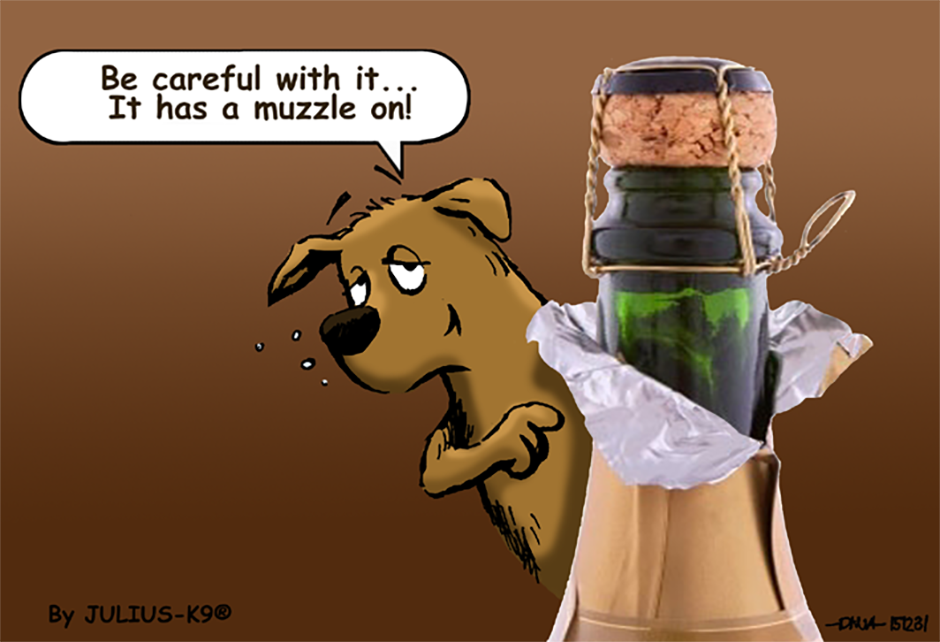For us humans, New Year’s Eve is about farewells to the events of the past year and welcoming in the New Year. We enjoy these celebrations but there’s no doubt that many dogs and other animals wish they could escape to a much calmer and quieter place. While we humans appreciate the visuals of fireworks, animals do not understand the noise that comes with such displays.
It is completely natural for a dog to get scared and confused by unusual sounds, as they do not understand what’s going on, and they may feel that something potentially harmful is going on. Many dogs look to their owners for some form of feedback about uncertain situations, so if they see them behaving calmly, they are less likely to be bothered about the sounds. However there is a significant amount of variation on this, and some dogs are particularly sensitive to stimuli from the outside world, therefore they need to be taught how not to be scared of fireworks.

If you have a puppy, the chances are that she has never encountered fireworks before, and therefore she will have no experience with them. If you’re expecting fireworks to go off nearby (for example, because of an event that you’re aware of), it is worth being prepared in advance. Close the windows in order to minimise the sound and get your dog’s favourite toy ready. As soon as you start hearing the bangs, try to get your dog to play. Don’t force it too much, especially if you see her getting unsettled about the sounds. Instead, try tempting her to play by pulling the toy in front of her and changing direction before she can catch it. Repeat this process every time you hear fireworks, so that your dog will begin to associate the loud bangs with playtime.
In case fireworks start going off nearby while you’re walking your dog, it is still best to try and get them to play. If you don’t have anything to play with, run with your dog or make her jump around, as exercise helps to reduce stress.
If your dog has previously experienced fireworks but is still scared of them, try to get her used to the bangs in a gradual way. For example, you can search for a firework video online and start playing it quietly while you play with her. Only turn the volume up when the initial level doesn’t bother her at all. Once she gets used to the noise in a closed area indoors, you can try moving on to the next stage of getting her to listen to fireworks sounds during a walk, from a distance.
[ultimate_icon_list icon_size=”25″][ultimate_icon_list_item icon=”Defaults-paw”]If you have the opportunity, choose a place to celebrate New Year’s Eve that’s far from inhabited areas, to reduce the risk of hearing loud noises like fireworks.[/ultimate_icon_list_item][ultimate_icon_list_item icon=”Defaults-paw”]If your dog is terrified of the noises fireworks make, perhaps even running off before in terror, it may be worth consulting with your vet and asking about a tranquiliser to give her to help her stay calm.. Never give human medicines to your pet: veterinary supervision is essential![/ultimate_icon_list_item][ultimate_icon_list_item icon=”Defaults-paw”]Make sure your dog always has an ID tag on her collar with your contact details on it. If she does go missing, there’s a greater chance of finding her than if she just had a microchip. Having said this, it’s still very important to, make sure the microchip is properly registered on an accessible internet database, with your up-to-date contact details.[/ultimate_icon_list_item][ultimate_icon_list_item icon=”Defaults-paw”]Plan a huge walk for the 31
of December to make sure your pet are tired by evening time.[/ultimate_icon_list_item][ultimate_icon_list_item icon=”Defaults-paw”]Make sure before the walk that the collar or harness is tight enough so that your dog cannot wriggle out of it. With the increased risk of a dog being startled by a firework at this time of year, you may even wish to use two different leashes, one on the collar and one on the harness, if you feel safer that way.[/ultimate_icon_list_item][ultimate_icon_list_item icon=”Defaults-paw”]Do not let your dog out even in your own garden, after dark without supervision.[/ultimate_icon_list_item][ultimate_icon_list_item icon=”Defaults-paw”]If you have a dog that normally sleeps outdoors, lock her in a safe place for the night, or better again, as an exception, let her spend the night in your home.[/ultimate_icon_list_item][ultimate_icon_list_item icon=”Defaults-paw”]Prepare your dog a cosy and safe den inside your home. If you have a transportation crate or kennel and she likes it, set it up for her. You may wish to cover it with something like a sheet or blanket to further screen her from loud sounds or flashes of light.[/ultimate_icon_list_item][ultimate_icon_list_item icon=”Defaults-paw”]Since most dogs are less bothered by familiar noises, it can help to turn on noisy household equipment (such as a washing machine) in the house, or play loud background music in order to cover up the noises from outside.[/ultimate_icon_list_item][ultimate_icon_list_item icon=”Defaults-paw”]Go ahead and reassure your dogs by petting them! It is a misconception that stroking them will strengthen their fears. To the contrary, ignoring their fear may be equal to abandoning them, from their perspective.[/ultimate_icon_list_item][ultimate_icon_list_item icon=”Defaults-paw”]Although research says it does not work for every dog, soothing pheromones or essential oil vaporisers may help them to stay calm, and distracting them by playing with a rubber ball or a favourite toy may also help.[/ultimate_icon_list_item][/ultimate_icon_list]


